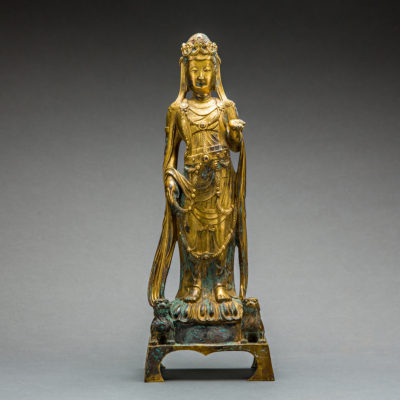
| SKU | LM.66 |
|---|---|
| Circa | 1644 AD to 1912 AD |
| Medium | Gilt Bronze |
| Origin | China |
| Gallery Location | UK |
The Qing dynasty ? (1644-1911) was the last imperial dynasty in China. It was founded by the non-Chinese people of the Manchus who originally lived in the northeast, a region later called Manchuria. The Manchus used the disintegration of the central government of the Ming empire ? (1368-1644) to conquer China. They established a political system that successfully integrated the Chinese intellectuals into the administration of the empire. The Manchu people was organised militarily in the Eight Banners (baqi ??) and lived in “Manchu cities” in Beijing and most provincial capitals. Guanyin is an East Asian bodhisattva associated with compassion as venerated by Mahayana Buddhists. She is commonly known as the “Goddess of Mercy” in English. The name Guanyin is short for Guanshiyin, meaning “[The One Who] Perceives the Sounds of the World”. She is also referred to as Guanyin Bodhisattva (traditional Chinese: ?????; simplified Chinese: ????; pinyin: Guan shì Yin Pú Sà).[1] Some Buddhists believe that when one of their adherents departs from this world, they are placed by Guanyin in the heart of a lotus, and then sent to the western pure land of Sukhavati.[2] Guanyin is often referred to as the “most widely beloved Buddhist Divinity”[3] with miraculous powers to assist all those who pray to her as listed in the Lotus Sutra and Karandavyuha Sutra. Several of the biggest temples in East Asia are dedicated to Guanyin including Shitennoji, Sensoji, Kiyomizu-dera and Sanjusangendo as well as Shaolin. Guanyin is beloved by all Buddhist traditions in a non-denominational way and can be found in some of the most important centers of Indian Buddhism including the Mahabodhi Temple, Ajanta Caves and Nalanda Museum as well as most Tibetan temples where He is referred to as Chenrezig. Furthermore, Guanyin can also be found in some influential Theravada temples such as Gangaramaya and Kelaniya of Sri Lanka as well as the Asian art sections of most museums in the world as a widely depicted subject of Asian art and sculpture. It is generally accepted among East Asian adherents that Guanyin originated as the Bodhisattva Avalokitesvara. Commonly known in English as the Mercy Goddess or Goddess of Mercy but often depicted as both male and female to show this figure’s limitless transcendence beyond gender[4] Guanyin is also revered by Taoists as an immortal. In Chinese folk religion, there are mythical accounts about Guanyin’s origins that are not associated with the Avalokitesvara described in Buddhist sutras.
Login to view price
Sign-up to receive the latest Wedding Estates news and promotions!

